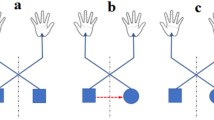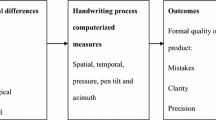Abstract
When producing a drawing and when copying a geometrical pattern, the subject organizes the sequence of his or her graphic movements (strokes) in a way which is by no means ad hoc or arbitrary. Specifically, the manual execution of a geometrical pattern appears to be governed by a set of biases determining the starting points, stroke directions and stroke order of the graphic-production sequence. These constraining principles are often called ‘rules’, although they have a probabilistic rather than a deterministic status. The ‘rules’ also appear to have different strength. The present study attempts to assess the strength values of each of eight such ‘rules’ given a specific set of patterns. The experiment collects stroke-sequence data of fifteen adult subjects copying a well-defined set of 149 geometrical patterns twice. Subsequently, their behavior is simulated by a computer algorithm in which the weights of eight ’rules’ are optimized, minimizing the deviation between the frequency distributions of the simulated and the original stroke sequences. The model operates in a probabilistic fashion according to several stages dealing with each subsequent stroke successively. The weights obtained allow the model to produce 88 percent of the patterns in the same way as the human subjects did. It is shown that further refinements should improve on this performance. A brief discussion of behavioral data such as reaction times and kinematic features illuminates the facilitatory function of several of the graphic production rules.
1) The reported research was in part performed by the second author as one of his MA assignments at the Department of Experimental Psychology, University of Nijmegen. It was conducted in the framework of NWO Project 560-259-035 ‘Graphic production’. Further support was received from ESPRIT Project 419 ‘Image and movement understanding’. The present article was written while the first author was a Fellow at the Netherlands Institute for Advanced Study (NIAS). Technical assistance by Dr. Frans Maarse and mathematical advice by Professor Eddy Roskam are gratefully acknowledged.
Access this chapter
Tax calculation will be finalised at checkout
Purchases are for personal use only
Preview
Unable to display preview. Download preview PDF.
Similar content being viewed by others
References
Goodnow, J.J. & Levine, R.A. (1973). “The grammar of action”: Sequence and syntax in children’s copying. Cognitive Psychology, 4, 82–98.
Goodnow, J.J., Friedman, S.L., Bernbaum, M. & Lehman, E.B. (1973). Direction and sequence in copying: The effect of learning to write in English and Hebrew. Journal of Cross-Cultural Psychology, 4, 263–282.
Lehman, E.B. & Goodnow, J.J. (1975). Directionality in copying: Memory, handedness, and alignment effects. Perceptual and Motor Skills, 41, 863–872.
Maarse, F.J. (1987). The study of handwriting movement: Peripheral models and signal processing techniques. Lisse: Swets & Zeitlinger Publishers.
Meulenbroek, R.G.J. & Thomassen, A.J.W.M. (1990). Stroke-direction preferences in drawing and handwriting. Human Movement Science, (in press).
Meulenbroek, R.G.J. & Thomassen, A.J.W.M. (in preparation). Stroke-direction preferences as a function of arm position, handedness, and hand posture.
Nachshon, I. (1983). Directional preferences of bilingual children. Perceptual and Motor Skills, 56, 741– 750.
Nachshon, I. & Alek, M. (1981). The development of directional preferences: Cross-cultural differences. Psychologia, 24, 86–96.
Nihei, Y. (1983). Developmental change in drawing and handwriting. Acta Psychologica, 54, 221–232.
Ninio, A. & Lieblich, A. (1976). The grammar of action: Phrase structure in children’s copying. Child Development, 47, 846–849.
Rosenbaum, D.A., and Jorgensen, M.J. (1991). Planning macroscopic aspects of manual control. Human Movement Science, (in press).
Rosenbaum, D.A., Vaughan, J., Barnes, H.J., Marchak, F., and Slotta, J. (1990). Constraints on action selection: Overhand versus underhand grips. In M. Jeannerod (Ed.), Attention and performance XIII (pp. 321–342). Hillsdale, NJ: Erlbaum.
Simner, M.L. (1981). The grammar of action in children’s printing. Developmental Psychology, 17, 866– 871.
Simner, M.L. (1984). The grammar of action and reversal errors in children’s printing. Developmental Psychology, 20, 136–142.
Smyth, M.M. (1989). Visual control of movement patterns and the grammar of action. Acta Psychologica, 70, 253–265.
Teulings, H.-L. & Maarse, F.J. (1984). Digital recording and processing of handwriting movements. Human Movement Science, 3, 193–217.
Teulings, H.-L. & Thomassen, A.J.W.M. (1979). Computer-aided analysis of handwriting movements. Visible Language, 13, 218–231.
Thomassen, A.J.W.M., Meulenbroek, R.G.J. & Hoofs, M.P.E. (1991). Economy and anticipation in graphic stroke sequences. Human Movement Science, (in press).
Thomassen, A.J.W.M., Meulenbroek, R.G.J., and Tibosch, H.J.C.M. (1990). Latencies and kinematics reflect graphic production rules. Human Movement Science, (in press).
Thomassen, A.J.W.M. & Teulings, H.-L. (1979). The development of diretcional preference in writing movements. Visible Language, 13, 299–313.
Thomassen, A.J.W.M., Tibosch, H.J.C.M., and Maarse, F.J. (1989). The effect of context on stroke direction and stroke order in handwriting. In R. PLamondon, C.Y. Suen, and M.L. Simner, (Eds.), Computer recognition and human production of handwriting. Singapore: World Scientific.
Van Sommers, P. (1984). Drawing and cognition. Cambridge: Cambridge University Press.
Van Sommers, P. (1989). A system for drawing and drawing-related neuropsychology. Cognitive Neuropsychology, 6, 117–164.
Author information
Authors and Affiliations
Editor information
Editors and Affiliations
Rights and permissions
Copyright information
© 1991 Springer Science+Business Media Dordrecht
About this chapter
Cite this chapter
Thomassen, A.J.W.M., Tibosch, H.J.C.M. (1991). A Quantitative Model of Graphic Production. In: Requin, J., Stelmach, G.E. (eds) Tutorials in Motor Neuroscience. NATO ASI Series, vol 62. Springer, Dordrecht. https://doi.org/10.1007/978-94-011-3626-6_22
Download citation
DOI: https://doi.org/10.1007/978-94-011-3626-6_22
Publisher Name: Springer, Dordrecht
Print ISBN: 978-94-010-5609-0
Online ISBN: 978-94-011-3626-6
eBook Packages: Springer Book Archive




